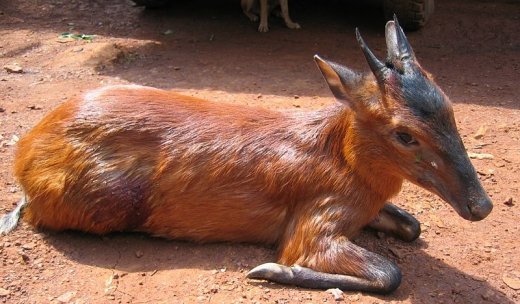|
Our
Beautiful World
|
Duikers, Cephalophinae
A duiker is any of about 21 small to medium-sized antelope species from the subfamily Cephalophinae native to Sub-Saharan Duikers are shy and elusive creatures with a fondness for dense cover; most are forest dwellers and even the species living in more open areas are quick to disappear into thickets. Their name comes from the Afrikaans/Dutch word for diver and refers to their practice of diving into tangles of shrubbery. With a slightly arched body and the front legs a little shorter than the hind legs, they are well-shaped to penetrate thickets . They are primarily browsers rather than grazers, eating leaves, shoots, seeds, fruit, buds and bark, and often follow flocks of birds or troops of monkeys to take advantage of the fruit they drop. They supplement their diet with meat: duikers take insects and carrion from time to time, and even stalk and capture rodents or small birds. The Blue Duiker has a fondness for ants. Abbott's Duiker, Cephalophus spadix  Adult Abbott's duiker, Cephalophus spadix Photographed December 2003 in a camera trap, Mwanihana Forest, Udzungwa Mountains, © Copyright Francesco Rivero, 2003, http://www.ultimateungulate.com Abbott's Duiker, Cephalophus spadix, also known as Minde in Swahili, is a large forest dwelling Duiker (small antelope) found only in a couple of scattered enclaves in Tanzania. It is believed by some to be a subspecies of the Yellow-backed Duiker. It is very rare and the first photograph was taken as recently as 2003. Abbott's Duikers stand around 65 cm tall at the shoulder and weigh approximately 55 kg . Abbott's Duikers have a glossy, dark brown coat which is lighter on the underside. The face is paler and gray in color, and there is a large red tuft on the forehead. Abbott's Duiker have short thin horns of 8 to 12 cm . Abbott's Duiker is endemic to Tanzania, occur in the Eastern Arc Mountains, Mount Kilimanjo, and South Highlands in scattered populations. They live in mainly in wet forests and swamps at between 1,700 and 2,700 metres above sea level, but can sometimes wander to much higher altitudes at 4,000 m. They eat mainly fruit and possibly other plant matter. Abbott's Duiker are nocturnal, spending the days at rest in thickets. They form regular pathways through the undergrowth, making them relatively easy to find. If threatened they generally try to run, though they have been known to kill pursuing dogs when left with no escape route. There are estimated to be less than 1,500 Abbott's Duiker left in the world, and there is no captive population. They are threatened by habitat destruction and hunting. Ader's Duiker, Cephalophus adersi
Black-fronted Duiker, Cephalophus nigrifrons  Black-fronted Duiker, Cephalophus nigrifrons http://en.wikipedia.org/wiki/File:Cephalophe_a_front_noir.jpg The Black-fronted Duiker, Cephalophus nigrifrons, is a small antelope found in central and west-central Africa. It averages 10 kg and a shoulder height of 43 cm. It has been found as far south as northern Angola. The species remains reasonably widespread with a total population in the order of 300,000. A number of subspecies are recognized, including a highly distinctive subspecies, the Rwenzori Red Duiker Cephalophus nigrifrons rubidus, which may be a separate species, in the alpine and subalpine zones of the Rwenzori Mountains on the Uganda/Congo-Kinshasa border. The Black-fronted Duiker occurs widely in swamp forests and alongside watercourses within the equatorial forest zone, from south-eastern Nigeria to the Albertine Rift, and in isolated montane forests in East Africa. The Nigerian population occurs in the Niger Delta and is probably disjunct from the nearest known population in Cameroon . Isolated populations of this species were recorded on Mounts Cameroon, Kupe and Manengube, but identification was uncertain.. Cephalophus nigrifrons rubidus is confined to the
Ruwenzori Mtns at altitudes of 1,300-4,200 m, although it is thus
far East (1999) suggested that the population of the Rwenzori Red Duiker may number at least in the thousands. Habitat and Ecology: Tropical forests of central Africa ranging
from lowland swamp forest and seasonally flooded forest sometimes recorded in secondary forest and farm-bush The total population is estimated at 380,000 individuals, with a declining trend.
|
| Links | |
| Antiloper og gaseller (norwegian) | |
| Antiloper: Dik dik (norwegian) | |
| Antiloper: Gnuen (norwegian) |
|
The
images used herein, except where otherwise stated, were obtained from
IMSI's MasterClips(MasterPhotos(C) Collection, 1895 Francisco Blvd.East, San Rafael, CA 94901-5506, USA |
 ANIMALS over 250 |
 BIRDS over 500 |
 FLOWERS over 225 |








